Cyclists Demand Access to Auckland Harbour Bridge
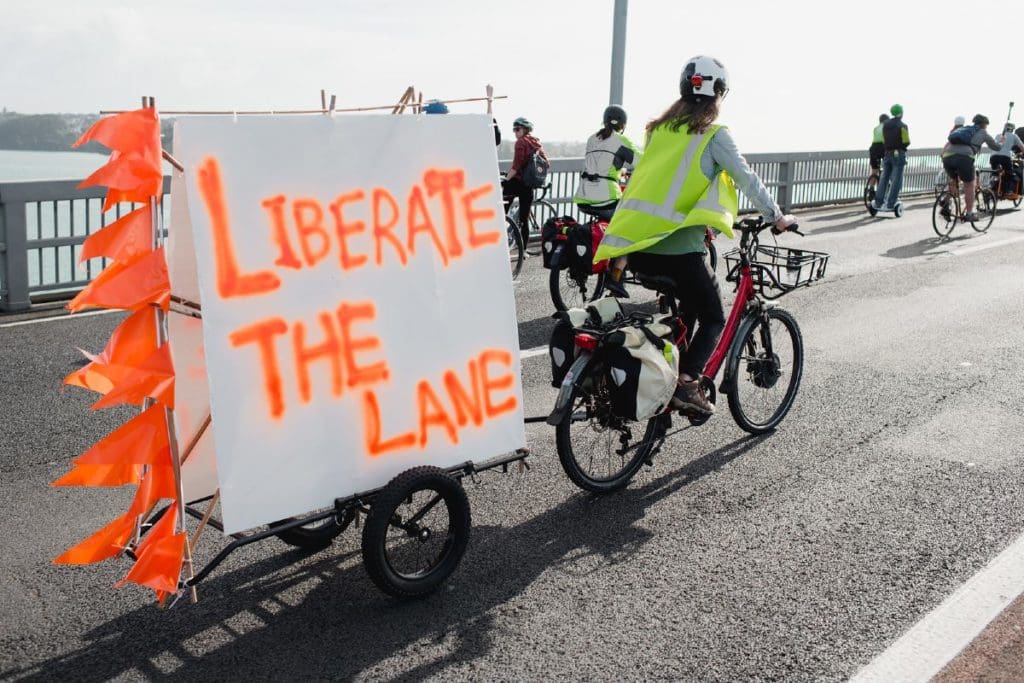
Auckland, New Zealand
Not unlike Sydney, Auckland is a city on two sides of a large harbour that is crossed by a single, iconic bridge. Needless to say, that eight lane bridge is extremely busy. But unlike Sydney, Auckland’s Harbour Bridge provides no lanes or access for pedestrians and cyclists whatsoever.
On Sunday 30th May about 1,500 cyclists took part in a ‘Liberate the Lanes’ protest by riding across the Auckland Harbour Bridge.
They had to get past a police barricade to do this and one protester who initially breached the cordon was arrested.
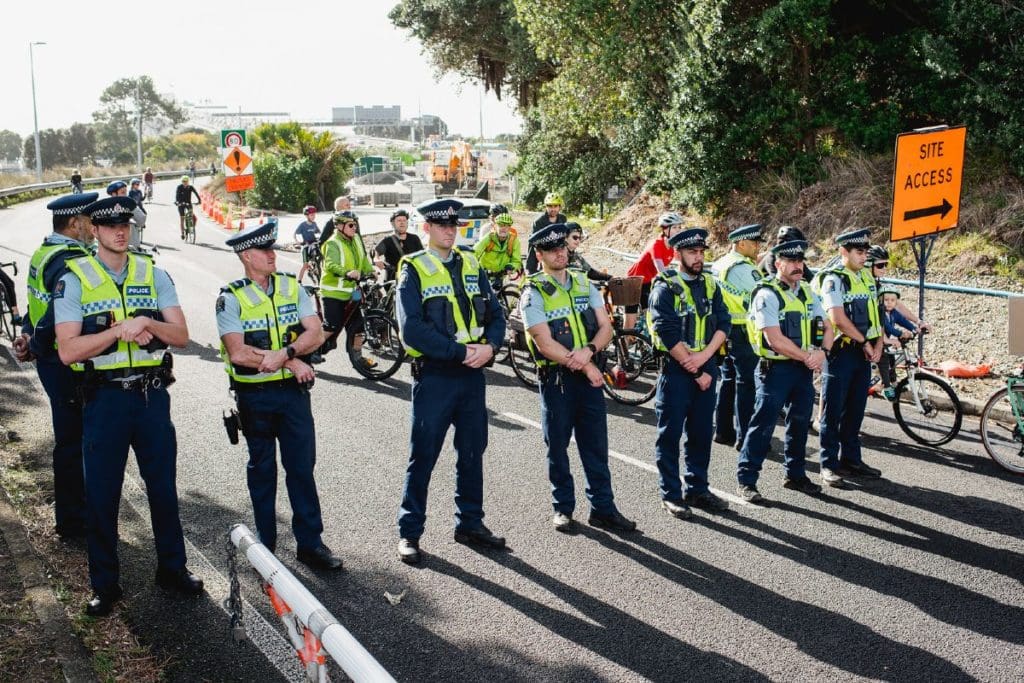
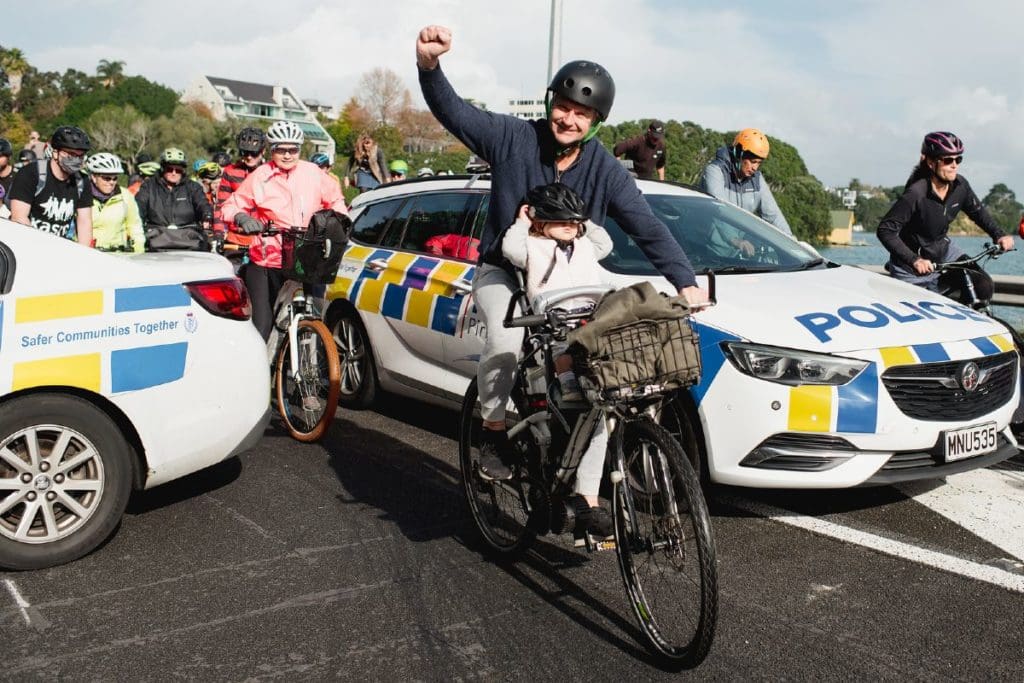
Speaking on Monday 31st May, New Zealand Prime Minister Jacinda Ardern said she agrees the North Shore needs to be connected to Auckland city, via modes of transport other than buses and cars.
“You’d be hard pressed to find people who don’t support that,” she said.
Ardern says the Government is working to provide a solution but there’s been several setbacks.
A long-planned cycling and walking path across the Bridge, Skypath, suffered another setback in March when technical issues surfaced. Transport Minister Michael Wood said at the time it hadn’t been cancelled, just delayed.
Ardern says the same thing.
“Engineers have come forward and said perhaps attaching is more problematic so we have to find another way, but I’m not against people finding other modes of transport.”
But cyclists don’t want to wait any longer.
Bike Auckland deputy chairperson Duncan Laidlaw says all they’re asking for is a three months trial of a cycle lane over the bridge.
“People have been waiting for decades – it’s now 12 years on from the first protest asking for a cycle lane.”
Both Laidlaw and Ardern stopped short of endorsing protesters breaking through the barricade however.
Ardern says it’s her job to keep people safe – so breaking through a police barricade is not something she can support.
“I understand their frustration but I am in a position where if someone was hurt we would be having a very different conversation.”
In ironic timing, just one week prior to the Auckland Harbour Bridge protest a major missing link called the 4.5 km long Southern Path along the Southern Motorway across a more southerly section of Auckland Harbour was opened. Construction of a further 4 km section is underway.
Meanwhile another important upgrade to Quay Street on the city’s waterfront was also just completing landscaping and other finishing touches.
A few days after the protest we spoke to Barb Cuthbert, Chair and Spokesperson for Bike Auckland.
“Our goal is to normalise cycling in every part of Aucklanders’ lives,” she explained.
“Our reach is very large. We have a very strong social media presence in Auckland.
“We are the key stakeholder for cycling for Auckland. We have one city for one and three quarter million people. We’ve got Auckland Council, Auckland Transport and the (national) transport agency (Waka Kotahi) and we are the key stakeholder for all of those agencies.”
Barb was keen to emphasise that Bike Auckland did not organise the bridge occupation, which happened organically.
“Remember it was two things,” she said. “One it was the rally that Bike Auckland organised. That happened from 10am to 11am. Then from 11am to about 1pm, people just took over the Harbour Bridge. That wasn’t part of the rally, but it was a fairly understandable thing for about 1,500 people to do. We had about 2,500 people at our rally and then about 1,500 rode the bridge.”
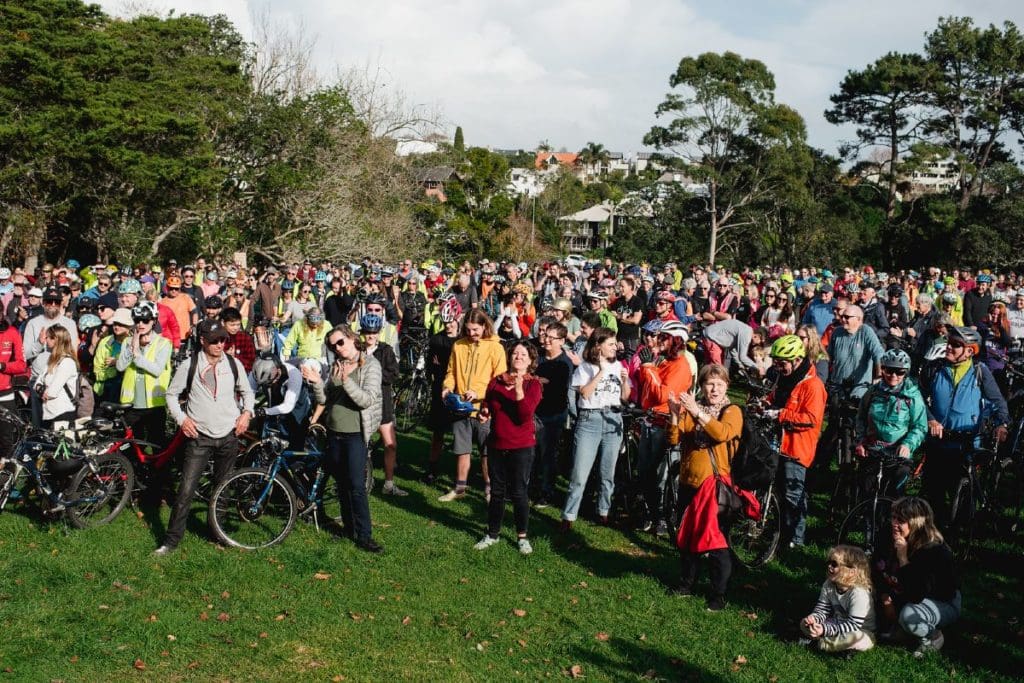
Nevertheless it was the bridge occupation that immediately gained national and even international media attention.
“Absolutely vast! It was huge,” Barb continued. “Both the main TV news channels, all the print media. We even had the London Guardian interested. I’ve been flat out, but in a good way, because there’s a huge amount of interest in the issue of the bridge.
“It’s just appalling that you can’t bike across the Auckland Harbour Bridge.
“I think Auckland is really progressing in cycling. I used to go to Australia to see what was happening in cycling – Sydney, Melbourne and Brisbane. I don’t do that now, because we’re spending hundreds of millions of dollars improving cycling in Auckland. But we were starting off a very low base. You don’t do that overnight, but we are progressing.
“Every time we message on the bridge it gets huge engagement.
There was a public private partnership scheme that was about to be built but in 2018 the government said, ‘No, this should be a public project. Waka Kotahi, you should build it.’ And they’ve been dragging the chain since then. They brought out a fabulous design in 2019, then they found they couldn’t build that, which makes you wonder about their competence.
“Now they’ve got 50 staff working in a back room somewhere on the next design, but that won’t be coming along for the next five years.”
Barb was too diplomatic to make any further comment on this point, but clearly the claim by Waka Kotahi about 50 staff working on the project for so long to come up with a new design is either a lie, a sign of gross incompetence, a total lack of productive ambition or some combination of these factors.
“We’ve got more and more ebikes,” Barb resumed. “Ebikes have taken off in Auckland because of our contour and privately owned e-scooters as well.
“The ferries can’t cope with that demand, so we’ve said we need one lane on the Harbour Bridge through the summer, for a trial, so we can understand what level of demand will be met by people on bikes and scooters.
“No traffic modelling will give you that information, because traffic modelling is designed for car and truck movements, not really for bike movements. So that’s the purpose for the January, February, March trial on the bridge.
“Long term we’d like a completely separate cycling and walking facility. That will come along in five, six, seven years, but in the meantime we’ve got to have something to allow people to get across the harbour.
“Our most effective levers are bridge occupation. The bridge is critical to Auckland.
This is something we’ve been reluctant to do. We actually asked the transport agency about five times since December to open the bridge for a public event.
There’s a big debt owed to Aucklanders who have been waiting so long for this facility. They now need to step up and help make the trial a success.
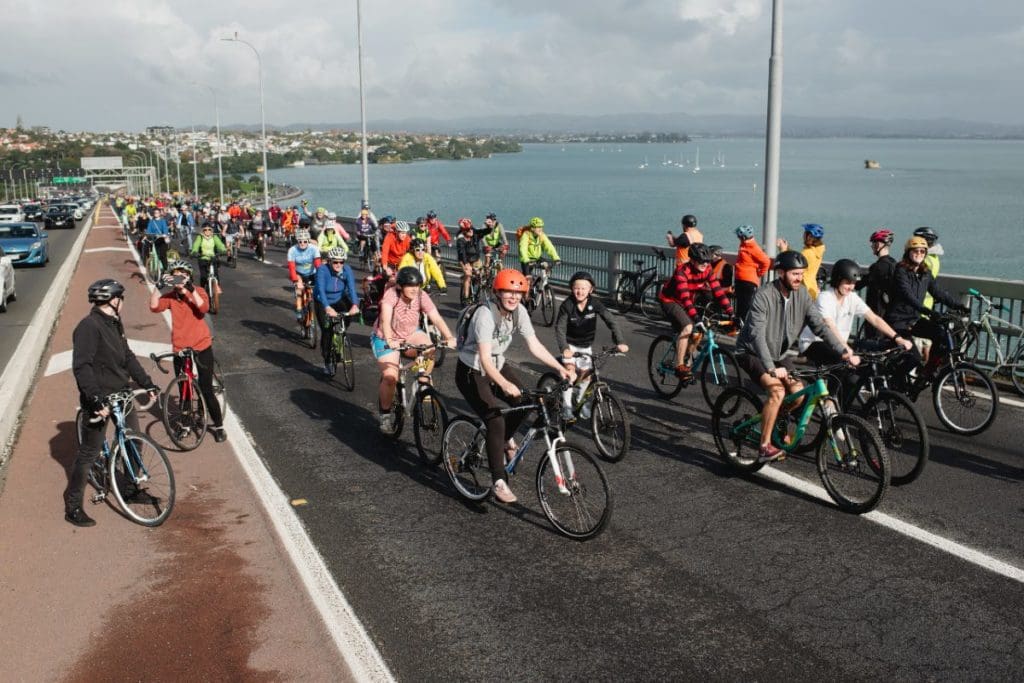
“With the massive ebike uptake – New Zealand now has as many ebikes being imported as cars, I believe there will be a shift out of cars and to bikes.
“All of the international trends are shifting to ebike uptake, more cycling, more scooters, we’re just following the international trend.
“Auckland Transport has been poling Aucklanders about their transport preferences for about five years and consistently 60% of Aucklanders say they would bike more if they had a save network.
“We are building the network, but it’s too slow. But more people are cycling. We had a 16% increase in cycling (in total) for the three years pre-covid.
“More people post-covid are now working from home, which means we’ve got a declining car use across to harbour bridge, so we’ve got scope to trial this. We’re not trying to cause havoc.”
Progress Being Made?
Five days after the protest the NZ government confirmed plans for a brand-new cycling and walking bridge across the Waitematā Harbour – at an estimated cost of NZ$685 million (A $640 million).
The new bridge will not carry buses or other vehicles.
The project is now approved and funded – and is expected to take five years to consent and build.
The ‘indicative design’ shows viewing screens for the entire length of the bridge, with stepped seating along its outer edge.
It will be a ‘purpose-designed quality option’ and an ‘outstanding piece of tourism infrastructure’, NZ Transport Minister Michael Wood said.
In the days following the announcement there has been pushback by a trucking industry spokes person and various opposition politicians. The saga continues…
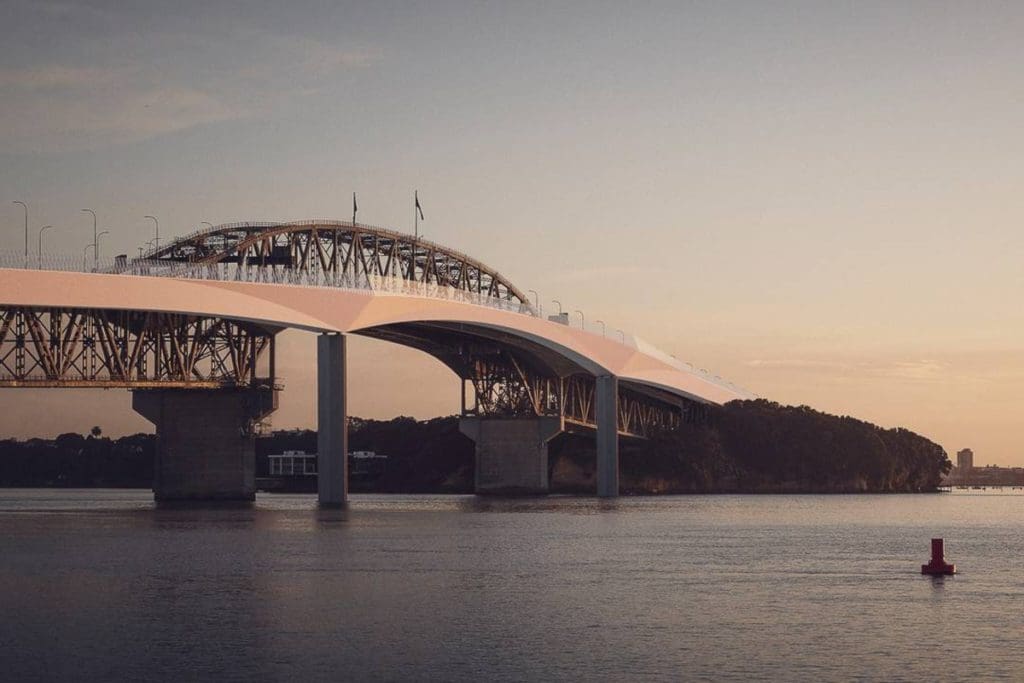
Some of the first section of this article was first published on newshub.co.nz and a small portion in the New Zealand Herald.
